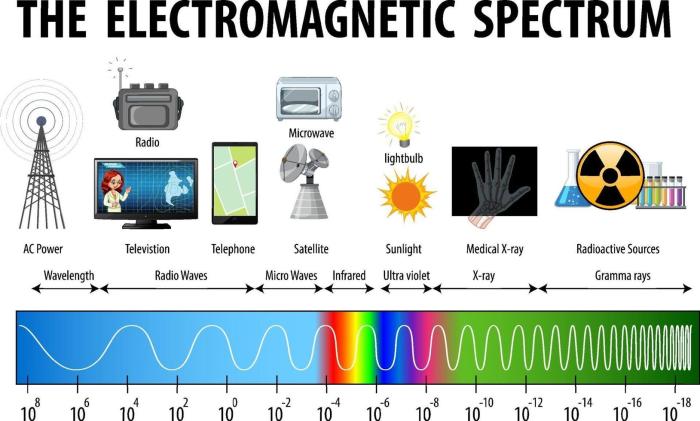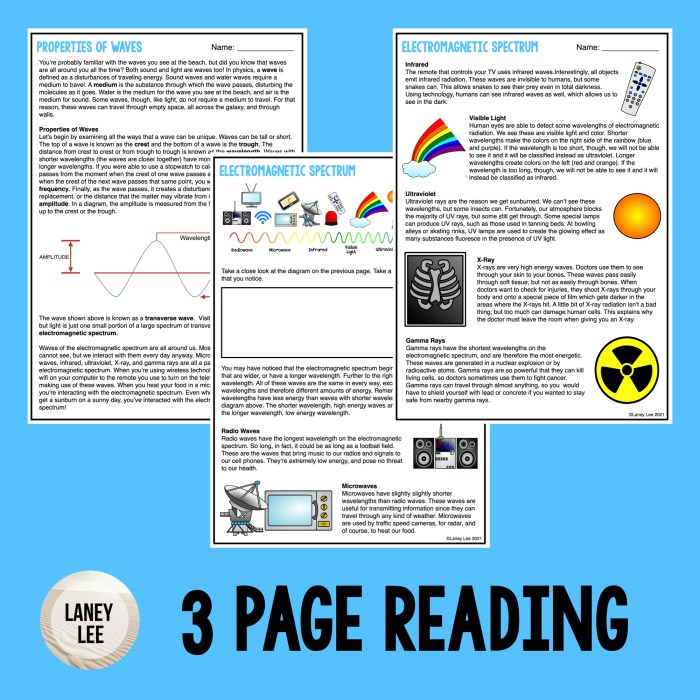Embark on a scientific voyage with our science 8- electromagnetic spectrum worksheet, an indispensable tool for unraveling the mysteries of the electromagnetic spectrum. This interactive resource empowers students to delve into the captivating world of electromagnetic waves, their properties, and their diverse applications across scientific disciplines.
Prepare to illuminate your understanding of radio waves, microwaves, infrared radiation, visible light, ultraviolet radiation, X-rays, and gamma rays, exploring their unique characteristics and the remarkable technologies they underpin.
1. Introduction

The electromagnetic spectrum is a vast range of frequencies of electromagnetic radiation. It includes visible light, radio waves, microwaves, infrared radiation, ultraviolet radiation, X-rays, and gamma rays. The electromagnetic spectrum is important in science because it helps us understand the nature of light and other forms of electromagnetic radiation.
The different types of electromagnetic waves are classified according to their wavelength and frequency. Radio waves have the longest wavelengths and lowest frequencies, while gamma rays have the shortest wavelengths and highest frequencies.
2. Electromagnetic Spectrum Worksheet
An electromagnetic spectrum worksheet is a tool that can be used by students to learn about the electromagnetic spectrum. The worksheet typically includes a diagram of the electromagnetic spectrum, as well as questions and activities that help students to understand the different types of electromagnetic waves and their properties.
Students can use a worksheet to learn about the electromagnetic spectrum by completing the questions and activities. The questions and activities may ask students to identify the different types of electromagnetic waves, describe their properties, and explain how they are used in science and technology.
3. Types of Electromagnetic Waves
The different types of electromagnetic waves are:
- Radio waves
- Microwaves
- Infrared radiation
- Visible light
- Ultraviolet radiation
- X-rays
- Gamma rays
Radio waves are used for communication, such as in radios and cell phones. Microwaves are used for cooking and heating food. Infrared radiation is used in night vision devices and heat-seeking missiles. Visible light is the type of electromagnetic radiation that we can see.
Ultraviolet radiation is used in tanning beds and for disinfecting surfaces. X-rays are used in medical imaging and security scanners. Gamma rays are used in cancer treatment and nuclear power plants.
4. Properties of Electromagnetic Waves
The properties of electromagnetic waves include:
- Wavelength
- Frequency
- Energy
Wavelength is the distance between two consecutive peaks or troughs of a wave. Frequency is the number of waves that pass a given point in one second. Energy is the amount of energy carried by a wave. The wavelength, frequency, and energy of an electromagnetic wave are all related.
The shorter the wavelength, the higher the frequency and the greater the energy.
5. Applications of the Electromagnetic Spectrum

The electromagnetic spectrum has a wide range of applications in science, including:
- Communication
- Medicine
- Astronomy
Electromagnetic waves are used for communication in a variety of ways, such as in radios, cell phones, and satellites. In medicine, electromagnetic waves are used for imaging, such as in X-rays and MRI scans. In astronomy, electromagnetic waves are used to study the stars and other objects in space.
6. Safety and Health Considerations: Science 8- Electromagnetic Spectrum Worksheet

Exposure to electromagnetic waves can have potential safety and health hazards. These hazards include:
- Skin damage
- Eye damage
- Cancer
The risk of these hazards depends on the type of electromagnetic wave and the amount of exposure. It is important to take precautions to minimize exposure to electromagnetic waves, such as wearing protective clothing and avoiding prolonged exposure to high-power sources.
Questions and Answers
What is the electromagnetic spectrum?
The electromagnetic spectrum encompasses the entire range of electromagnetic waves, from low-frequency radio waves to high-energy gamma rays.
How can I use the science 8- electromagnetic spectrum worksheet?
The worksheet provides activities and exercises to help students learn about the different types of electromagnetic waves, their properties, and their applications.
What are the potential hazards of exposure to electromagnetic waves?
Exposure to high levels of electromagnetic waves can have adverse health effects, such as tissue damage and cancer.
